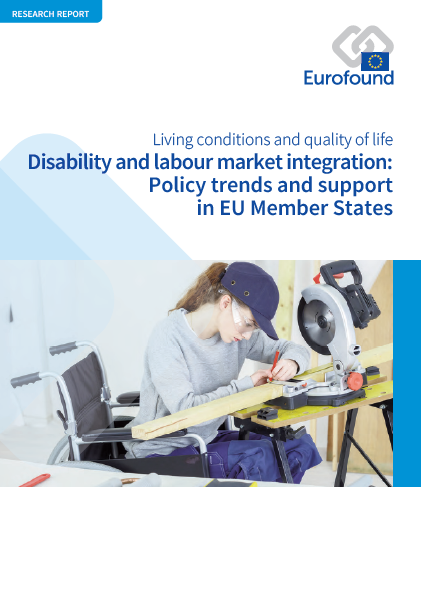
A jelentés azt vizsgálja, hogy az uniós tagállamok milyen szakpolitikákat alakítottak ki a fogyatékossággal élő személyek nyílt munkaerőpiaci integrációjának támogatása érdekében, különös tekintettel a munkába állás, a munkahely megtartása és a távollét utáni visszatérés három szakaszára. Több mint 150 különböző szakpolitikai intézkedés működési mechanizmusát és hatékonyságát járja körül, amelyek a Covid19-világjárvány előtt az EU-ban alkalmazott szempontokkal foglalkoztak: a munkahelyteremtéssel, a munkaerő-kínálattal, a munkaerő iránti kereslettel és a környezeti tényezőkkel. Emellett aktuális elemzést ad a járvány kezdetén, a fogyatékossággal élő személyek munkaerőpiaci helyzetének támogatására létrehozott korai szakpolitikai intézkedésekről. A tanulmányt egy Írországról szóló országos esettanulmány egészíti ki, amely általánosabb szempontból vázolja fel a fogyatékosság és a támogató rendszerek összetettségét. A jelentés az eddigi tanulságokra támaszkodva szakpolitikai iránymutatásokat fogalmaz meg a fogyatékossággal élő személyek nyílt munkaerőpiaci integrációjának javításához.
Key findings
Despite recent progress, labour market participation remains a challenge for people with disabilities - a fact compounded by COVID-19. A variety of obstacles – ranging from disability-related stereotypes to a lack of a strategic vision in governance – make employment in the open labour market more difficult for people with disabilities.
Responses to protect people with disabilities against job loss during the pandemic have often been limited. To ensure that they are not left behind in the recovery from the COVID-19 crisis, appropriate financial resources are needed to enable disability-inclusive solutions.
Labour market support measures must take account of disability and tailor policy responses to support the inclusion of people with disabilities in employment. All actors – governments, employers and NGOs representing the voices of people with disabilities – play an important role in the provision of support.
More high-quality data, broken down by disability type and comparable across the EU, are necessary to ensure the effective integration of people with disabilities into the labour market. Measures to support people with disabilities must also be systematically evaluated and the results fed back into policymaking.
While supporting and promoting the labour market participation of people with disabilities is crucial, adequate and inclusive social protection mechanisms also need to be put in place to ensure support is available for all people with disabilities, irrespective of their employment status.
The report contains the following list of tables and figures.
List of tables
- Table 1: Employment, poverty and social exclusion issues for people with disabilities, as reported in the 2020 European Semester country reports
- Table 2: Perceived role of different actors in EU Member States regarding the integration of people with disabilities into the open labour market
- Table 3: Distribution of policies by country and cluster, EU27 and the UK
- Table 4: Overview of quota systems in EU Member States
List of figures
- Figure 1: EU policies and initiatives
- Figure 2: Policy measures by key type
- Figure 3: Measures by key beneficiaries
- Figure 4: Measures assessed/evaluated by presence or absence of support from EU funds
- Figure 5: Number of policy measures identified supporting job creation by country
- Figure 6: Mechanisms, outcomes and effectiveness of incentives for employers
- Figure 7: Mechanisms, outcomes and effectiveness of quota systems
- Figure 8: Mechanisms, outcomes and effectiveness of entrepreneurship support
- Figure 9: Mechanisms, outcomes and effectiveness of social enterprises
- Figure 10: Mechanisms, outcomes and effectiveness of public procurement and public works
- Figure 11: Number of policy measures identified supporting employees and jobseekers by country
- Figure 12: Mechanisms, outcomes and effectiveness of all-encompassing and individual support
- Figure 13: Mechanisms, outcomes and effectiveness of guidance and counselling
- Figure 14: Mechanisms, outcomes and effectiveness of skills enhancement and assessment and transition from education
- Figure 15: Mechanisms, outcomes and effectiveness of vocational rehabilitation
- Figure 16: Number of policy measures identified supporting the employing organisation by country
- Figure 17: Mechanisms, outcomes and effectiveness of workplace adaptations and assistance
- Figure 18: Mechanisms, outcomes and effectiveness of retention support and awareness-raising
- Figure 19: Number of policy measures supporting the institutional environment by country
- Figure 20: Mechanisms, outcomes and effectiveness of legal instruments
- Figure 21: Mechanisms, outcomes and effectiveness of intermediation between demand and supply: matching services and placements
- Figure 22: Mechanisms, outcomes and effectiveness of capacity building
- Number of pages
-
86
- Reference nº
-
EF20013
- ISBN
-
978-92-897-2168-4
- Catalogue nº
-
TJ-02-21-332-EN-N
- DOI
-
10.2806/143896
- Permalink
Cite this publication
Eurofound (2021), Disability and labour market integration: Policy trends and support in EU Member States, Publications Office of the European Union, Luxembourg.